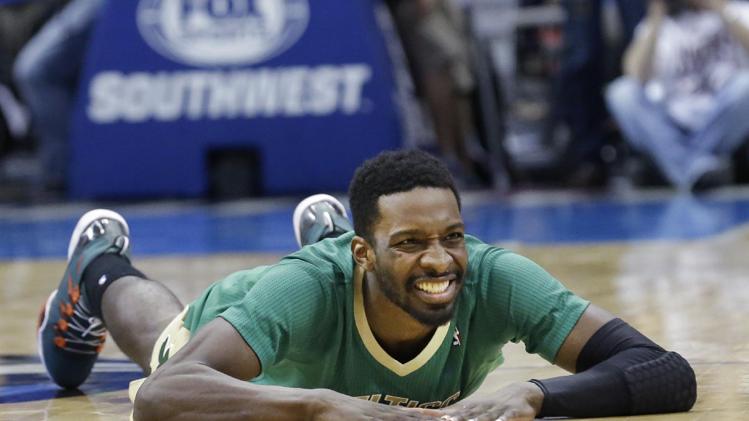Every morning, we compile the links of the day and dump them here… highlighting the big storyline. Because there’s nothing quite as satisfying as a good morning dump.
“I can care less about what other people have to say about my performance. You know, everybody’s entitled to their own opinion, so I really don’t pay attention to it. I’m just trying to come into each year being healthy and being able to play this game.”
He has 12 games of 25 or more points this year and 12 in single figures. After going for 27 points on 10-for-21 shooting against New York last Wednesday, he posted nine on 2-for-14 marksmanship against Phoenix on Friday. And after tying his season peak with 39 in an overtime loss Sunday in New Orleans, Green made just 2-of-12 shots and turned the ball over six times on the way to five points in another tight loss in Dallas on Monday.
Though he cited first-half stomach problems after his latest valley, he expected more of himself. But he wasn’t able to shake the bad shooting.
Just as he can’t shake the expectation of others that such nights should not be a part of his profile. The suggestion has been made that viewers don’t understand how difficult it is to scale the scoring heights.
“Of course,” Green said. “They don’t know, because they haven’t been through it. That’s why I say I can care less what people say. They can talk and say whatever they want to say. You know, I don’t give a (expletive). It don’t bother me.”
Boston Herald – Just happy to be here
It’d take a team of global researchers, test tubes, and loads of grant funding to begin to identify just why Jeff Green plays the way he does. If you skim through the rest of the article, you’ll see that Jeff admits to taking the same shots every game regardless of the result, and that “It just depends on the game and how it’s going”. That thought process makes sense, as you can never really predict how the shots are going to fall, but Green’s case just seems supernatural; like if he drops 30 points, he’s required to shoot 20% in the next game. Many point to his aggression (or lack of), but that doesn’t always explain it. Yes, he may be exaggerating a tad when claiming that he takes the same shots every game. We’ve seen him attack the bucket 10+ times in a single game and then seemingly disappear from the paint for a week straight. But still, the curious case of Jeff Green’s shot percentage is an oddity.
By now, we should know what we get with Jeff Green, which coincidently enough is not knowing what we’ll get. Perhaps there’s a guy from Duke who can make these discussions fade away…
On Page 2: Boston’s transition D is defying logic
Consider this: The Boston Celtics rank fifth in the league in transition defense this season, according to data logged by Synergy Sports. Of the top 15 teams in the league in transition defense, 14 of them are playoff bound, with the Celtics the only outlier.
Boston’s placement defies logic. Teams with poor transition defense usually reside at the bottom of the league standings, unless their half-court sets are stingy enough to make up for it, which is how Boston operated in past seasons. Of the 11 worst transition defenses in the league this season, nine comprise a who’s who of lottery-bound squads and the two playoff hopefuls are teams currently clinging to the final spots in their conferences (Dallas, Atlanta).
In the 28 games that Boston has played since Rondo returned on Jan. 17, the Celtics are allowing only 1.007 points per play in transition, according to Synergy data. That number would lead the league by a fair margin if maintained. (Indiana is tops for the season at 1.053.)
It’s not hard to see Rondo’s impact there. The point guard is one of the key players in Boston’s transition defense, often tasked with picking up the ball-handler and forcing him to make a quick decision on the break.
ESPN Boston – Celtics’ heart shows in transition defense
I had no idea the Celtics had an above average transition defense, but I lack a mind analytical enough to notice something like that. What does stand out to me, is the 1.007 points per play in transition since Rondo’s return. It’s interesting that the number is so low when compared to Indiana’s League-leading 1.053. I say so because our number becomes even more improbable when you factor in that this includes several games where Rondo didn’t even play. Even further, we’ve only had a select few games where Rondo’s started with Avery Bradley. Imagine what the numbers could have been like had they played more together this year.
I think more than anything, this stat proves to be a strong first step in the Brad Stevens/Ron Adams system. Finding a balance between solid offensive rebounding, while still maintaining fantastic transition D is something Doc Rivers never achieved, and it’s something to improve upon even further as better talent makes its way to Boston this summer. It’s nice knowing that even with teams like Philadelphia and Milwaukee, who’ll likely be drafting this year’s surest game-changers — Boston can hang it’s hat on the fact that this team is led by a guy who can do more with less.
The rest of the links:
Masslive – Sullinger, Olynyk coexisting well | Will Chris Babb stick with the Celtics? | Rick Carlisle believes in Danny Ainge, Brade Stevens, C’s rebuilding plan
CSNNE – Blakely’s 10 players to watch during March Madness | Olynyk’s Rookie Diary | Cowens high on Kansas’ Joel Embiid
Add The Sports Daily to your Google News Feed!

